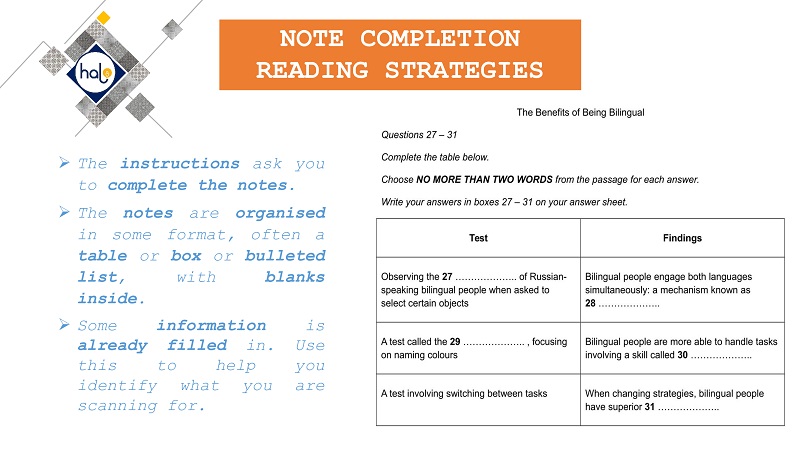IELTS Reading Note Completion Questions là dạng bài yêu cầu bạn hoàn thành một bài ghi chú dựa trên thông tin trong một bài đọc. Dạng bài này đòi hỏi thí sinh phải có khả năng đọc hiểu tốt, kỹ năng quét thông tin nhanh và khả năng xác định thông tin chính xác. Cùng Halo tham khảo bài mẫu chi tiết bên dưới nhé
Note Completion Questions

Note Completion Questions are a common type of fill-in-the-gap questions. The format can vary; mostly the notes are within a box, which means that they can look quite similar to a table. Indeed, there’s not much of a distinction between Note Completion and Table Completion Questions. The notes could also be in a bulleted list.
There will be a clear structure to the notes. Similar to an outline, including many of the ideas from the passage and key supporting points. The notes will always contain the numbered blanks in passage order.
Reading Strategies
Step 1: Check how many words or numbers you can include in each answer.
Step 2: Predict what sort of information you will need for each answer.

Step 3: Scan the passage for keywords that appear before or after the blank.
Step 4: Check that your answer fits properly.

Step 5: Copy the EXACT words/phrases from the passage in your answer.

How To Recognise
– The instructions ask you to complete the notes.
– The notes are organised in some format, often a table or box or bulleted list, with blanks inside.
– Some information is already filled in. Use this to help you identify what you are scanning for.

Sample Task
BEWARE OF THE DANGER TO BEES
A. In the last 10 years, the number of beekeepers in the UK has increased dramatically. According to the British Beekeeper Association (BBKA), the rise comes amidst growing international concern for the health of the global bee population. In 2007, the UK government proposed a budget cut that would defund the National Bee Unit, a group within the Department for Environment, Food and Rural Affairs that supports British beekeepers and is involved in the management of threats to bees.
B. In response to this, the BBKA launched a campaign to save the National Bee Unit, simultaneously drawing attention to the swiftly declining bee population. In the end, the National Bee Unit succeeded in keeping its funding, and the membership of the BBKA more than doubled. There are now around 24,000 amateur beekeepers registered with the association, and that number continues to rise.
C. At the same time that there has been an increase in the number of beekeepers in the UK, there has been a decline in the number of bees worldwide. Over the last decade, beekeepers in North America, South America, Europe and Asia have reported huge devastations to the bee populations in their hives. In 2007, former MP Lord Rooker predicted that the honeybee might be extinct in Britain within a decade.
D. Perhaps most troubling is the fact that the cause of this rapid decline has been hard to identify. Scientists point to the varroa mite as one explanation. This virus-carrying parasite preys on bees and has been threatening bee populations since the 1960s. Recently, researchers at Harvard University have argued that insecticides may deserve more of the blame. Neonicotinoids, a range of insecticides used by many farms, can be deadly to bees; they exterminated the entire population of bees in one Chinese province in the 1980s, and were an initial suspect in the phenomenon known as ‘colony collapse disorder.’
E. Colony collapse disorder occurs when all the worker bees from a beehive previously thought to be well-functioning and healthy suddenly disappear. The phenomenon was first observed by scientists and beekeepers in North America in 2006, in which some beekeepers lost up to 90% of their hives. While pesticides were at first believed to have caused the disappearance of the bees, further research has shown that a combination of two infections – a virus and a fungus -are far deadlier for bees than either would be on its own.
F. In this study, one hundred percent of collapsed hives were found to have traces of invertebrate iridescent viruses 01W; however, since these are often found in strong colonies, IN alone cannot be responsible for colony collapse. A variety of microbes that attack invertebrates were found in most of the collapsed colonies, but most could be eliminated as possible culprits, as they occurred in only a few collapsed hives.
G. However, one fungus called Nosema, which consists of a single cell and targets bees specifically, was found in most of the collapsed colonies in the study. Scientists determined that Nosema is not likely to predict the likelihood of collapse when found in an otherwise healthy hive, absent any traces of IIV; conversely, the presence of both Nosema and IIV is a strong indicator of the likelihood of collapse, given the high correlation of the two in collapsed colonies in the study.
H. Declining bee populations are troubling for a multitude of reasons. Bees directly produce items that humans consume in large quantities, such as beeswax and honey. It is the indirect production of bees, however, that would cause the largest devastation. Virtually everything humans eat depends on pollination, and bees are hugely important to the pollination process. Although cross-pollination is achieved in some cases by wind, insects account for a much larger proportion of plant reproduction, and bees are arguably the most prolific agents of pollen transport among insects.
I. If bees go extinct, most fruits and vegetables would die off as well. Animals, such as cows and pigs, who consume plants that reproduce with the help of bees would also be affected. The survival of bees, therefore, is tied to our consumption of beef, pork and dairy. The literal ‘fruits of the labour’ of bees also often become vital ingredients in important medicines. In short, if bee populations disappear, there will be an immensely detrimental impact on the global economy and life as we know it.
Questions 8-13
Complete the notes below. Write NO MORE THAN THREE WORDS AND/OR A NUMBER for each answer.
BEES IN THE UK AND AROUND THE WORLD
In the UK:
• A threat to funding for the 8 ……………..
• Publicity saved the funding and led to growing interest in bees.
• The number of officially registered 9 …………….. is 24,000, and continues to rise.
Dangers to bees:
• Sharp declines in bee populations around the world.
• In 2007, the honeybee was predicted to become extinct in the UK 10 ……………..
• The major problem is 11 …………….. in which all the worker bees in a hive thought to have been healthy are suddenly no longer there.
Possible causes of collapsed hives:
• IIV and microbes have been considered, but neither alone is the cause.
• A combination of Nosema, a 12…………….. and IIV indicate a likelihood of collapse.
Consequences of having fewer bees
• Less beeswax and honey
• Difficulty in growing food that depends on bees
• 13 …………….. may occur by wind, but depends on insects; bees are the most prolific.
Kết luận
Halo tin rằng với sự chuẩn bị kỹ lưỡng và luyện tập chăm chỉ, bạn hoàn toàn có thể nâng cao điểm số phần IELTS Reading. Hãy theo dõi Halo Language Center để cập nhật mọi tin tức mới nhất về kỳ thi IELTS nhé!
